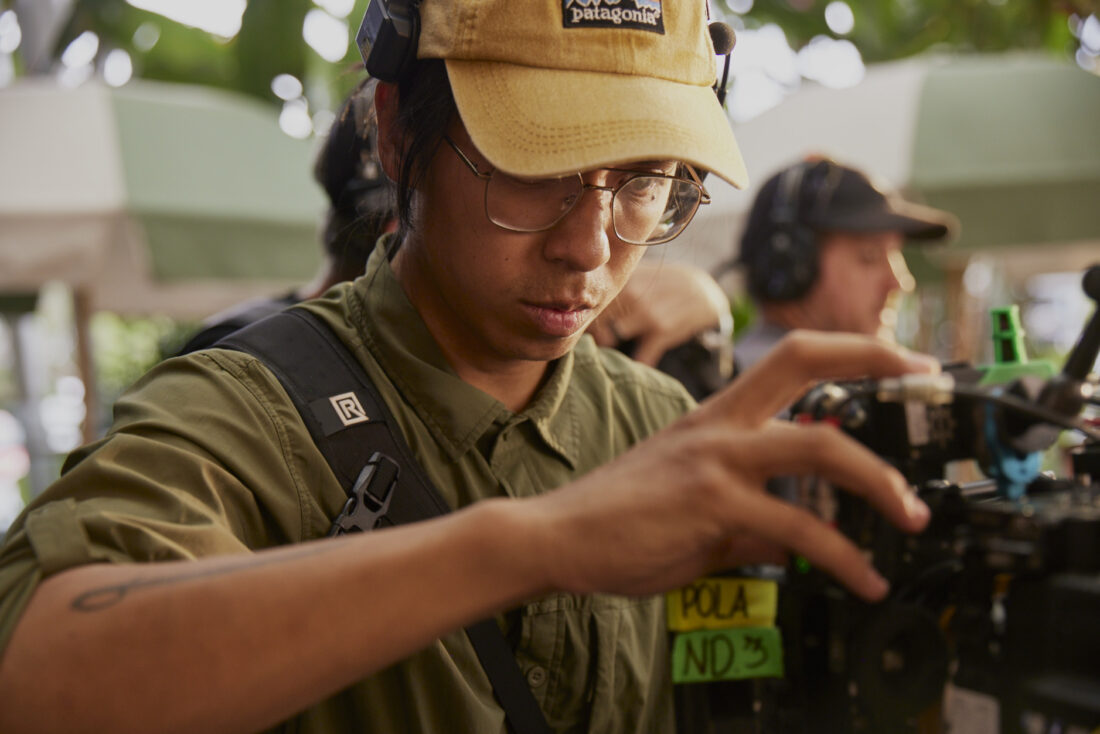Focus Puller: AC Magazine column
This column, “Crew Profile: The Focus Puller.”, written by Angela Cerasi of Peachy Keen Colour, was featured in the Australian Cinematographer Society’s “AC Magazine“.
Be organised. Do your homework. Understand editing. Communicate with DOP before shoot. And above all… stay focused! These are the attributes Melbourne and Brisbane-based technician, Phong Truong believes you need to make it as a focus puller. After interviewing him recently, Angela Cerasi wondered if amateur engineer, clairvoyant and yogi should be on the list too.
We all know film sets can be stressful, but Phong has a quietly held mission to stay zen, adding positivity and good humour when he can. He makes sure all of the cinematographer’s needs are met, and aims to foresee these needs before even being asked. As a focus puller and/or 1st AC, he is the steady right hand to the DOP, responsible for hiring and managing crew, organising logistics and systemising the camera kit into perfect working order. On set Truong positions himself as close to the camera as possible, observing and absorbing the way actors talk and move so he can learn their rhythm. All this to ensure he’s in the optimum position to pull focus and make the final film pin sharp.
An unusual trajectory led Phong to focus pulling. He studied Screen and Media Production at Griffith Film School for one year but switched to study business instead. He worked on set as a 2nd AC on his days off from the Queensland University of Technology and graduated with a Bachelor of Business. Truong believes the degree is where he learnt important leadership and management skills, including how to build and nurture business relationships. No one could argue this is a smart move in our industry where the gig-economy reigns supreme. It is these relationships which helped the technician quickly work his way up the ladder.
The recently awarded Australian Cinematographer of the Year, Ben Cotgrove was a great mentor and gave Truong a step up to 1st AC. He says it was Ben who generously shared the important lessons about what DOPs do and don’t like. Today Truong is one of the busiest TVC focus pullers in the country, and for this fact though, he credits his parents. Truong grew up as a son of Vietnam War refugees and this taught him the meaning of resilience, working hard and making whatever situation you’re in, work. During the war his parents endured unbelievable tales of civilian prison camps, living off food tickets, escaping through jungles and in the middle of the night on boats. This gave the focus puller a stoic work ethic. “It was hard coming up through the camera department in Australia as a Vietnamese person, and even as a young person, but if my parents went through a war and made it here okay, [this] should be a walk in the park.”
The best focus pullers lead by example with hard work and professionalism. A focus puller is often charged with the task of employing the 2nd AC, truck loader (an AC stationed in the camera truck on long form jobs), camera attachment and video split operator. At the rental house pre-shoot they check the gear; camera, lenses, fluid head, filters, matte box, wireless follow focus, rangefinder, video wireless transmitter and monitors. They build the camera from scratch and are responsible for the equipment which could be to the tune of half a million dollars.
Truong’s eyes light up when talking about tinkering at home in his garage of tech. His gadgets includes a 3D printer for creating handy things like camera brackets, antenna protectors and c-stand holders. Other useful accessories include a CineRT digital tape measure and focus bugs; placed in actor’s pockets on set and used for obtaining exact measurements and distances. A wireless hand unit (Arri Hi-5) is Truong’s most trusted piece of equipment. It offers wireless control of both lens and camera via a large knob, high-contrast LCD touch screen and a highly customisable modular design. Focus pullers often shadow the camera with the unit to see the physical distance of objects in front of the lens, actor’s movements, and to be as informed as possible before the camera rolls.
Despite all the tech, the principal act of pulling focus – honed by practise and repetition – seems more like an exercise in mindfulness. Truong himself admits he’s pretty content, enjoying the work/life balance of TVCs and the short-term intensity of the shoots. He loves the pressure of not much room for error and explains, “When I’m focus pulling everything is in slow motion, or slowed down by 30%.”
Some people say there are two types of focus pullers – zen or calculated. The calculated type uses T-marks, a depth of field calculator and reads the rangefinder to assess what settings will give the desired level of sharpness. Zen focus pullers tend to go with the flow and pull focus using their instinct and best judgement. I asked Phong where he classes himself and he pauses thoughtfully, “They are both good in their own way and are useful in different scenarios. TVC with untrained actors, Zen. A 200mm, T1.5 with an actor running towards camera from a LS to an ECU on their face – 100% Calculated. So I would say I’m a hybrid”. There is clearly a lot of technical knowledge and tricks of the trade involved in being a focus puller, but perhaps it’s this mix of an engineering brain and yogi mind which sums up the role perfectly.
Enjoy this article? If so let me know at angela@peachykeencolour.com.au or DM me at @angela_cerasi.
Interested in remote colour grading but not sure how it all works? Check out these blogs on how to supply your media here, and how to give the best creative brief even when you’re not in the room (including a free checklist) here. Check out Angela’s first AC magazine crew profile, on Production Designer Helen O’Loan, here.



